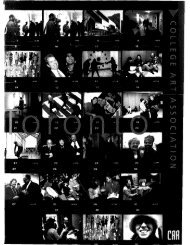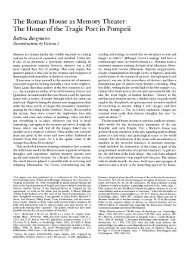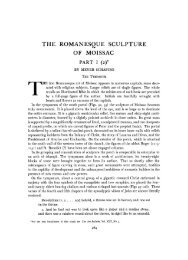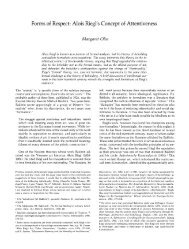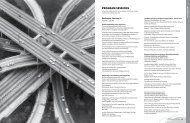THE HUMANISTIC THEORY OF PAINTING - College Art Association
THE HUMANISTIC THEORY OF PAINTING - College Art Association
THE HUMANISTIC THEORY OF PAINTING - College Art Association
Create successful ePaper yourself
Turn your PDF publications into a flip-book with our unique Google optimized e-Paper software.
UT PICTURA POESIS: <strong>HUMANISTIC</strong> <strong>THE</strong>ORY <strong>OF</strong> <strong>PAINTING</strong> 225<br />
ject-that are, Poussin means, representative of the behavior of different types of human<br />
beings under particular dramatic conditions.'24 And in insisting on the logic with which<br />
Poussin relates his complex human material to the dominant dramatic idea of his painting,<br />
Felibien and Le Brun show themselves, as we have seen, loyal disciples of the Cartesian<br />
doctrine that the reason has the power to impose its own valid order on "toutes les choses<br />
qui peuvent tomber sous la connaissance des hommes." Thus when the critics commented<br />
on the diverse, yet ordered rendering of the emotions in a painting, it was this doctrine<br />
which by and large intervened to discipline, if not actually dispel, the application of those<br />
elaborate rules for expression, gathered together by Le Brun, that reflected the mechanistic<br />
aspect of the Cartesian philosophy.<br />
Something closely akin to the Cartesian rationalism was strong in Poussin himself who,<br />
like Descartes, distrusted the mirage of sense perception'25 and valued only that selected<br />
and ordered knowledge which it was alone within the power of the clarifying reason to<br />
attain. "Mon naturel," he wrote to Chantelou in a famous letter of 1642, "me contraint de<br />
chercher et aimer les choses bien ordonn6es, fuyant la confusion qui m'est contraire et<br />
ennemie, comme est la lumidre des obscures t'n'bres."126 This passage written by a man<br />
who may never actually have read Descartes to express his sense of confusion at being<br />
requested to do within a given time a great deal more than he knew he could do well,<br />
might nevertheless have been written in another connection by Descartes himself.127 Some<br />
thirty years later when the admirable Boileau was writing in his L'art poitique what was<br />
to be perhaps the most influential statement in the history of French classicism of the rules<br />
for good poetry, he admonished the poets to love reason which alone could bestow value<br />
and lustre upon their labors,'28 and in a passage of which both the thought and the imagery<br />
remind one of Poussin's confession to Chantelou, remarks that only clear conceptions born<br />
of the light-dispensing reason, well thought out-in Poussin's phrase, "bien ordonn~es"-<br />
could result in clarity and precision of literary form:<br />
Il est certains Esprits, dont les sombres pensees<br />
Sont d'un nuage 6pais toiijours embarrassees.<br />
Le jour de la raison ne le sgauroit percer.<br />
Selon que nostre id&e est plus ou moins obscure,<br />
L'expression la suit, ou moins nette, ou plus pure.<br />
Ce que l'on congoit bien s'6nonce clairement.<br />
Et les mots pour le dire arrivent aiseiment.129<br />
When Boileau summed up the rules which the Academie Frangaise regarded as essential<br />
for correct writing in the various literary genres, he had been anticipated by a few years<br />
by those who legislated for the sister art of painting. Du Fresnoy's De arte graphica, based<br />
pretty squarely on Dolce and other Italians, owed the Cartesian philosophy little if any-<br />
thing. The author remarks, in fact, that he would not "stifle the Genius, by a jumbled<br />
124. When Poussin tells Chantelou to read his picture in<br />
order to see if "each thing is suited to the subject," he may<br />
well have meant to include other things (setting, drapery,<br />
etc.), besides the expressions. But the latter were evidently<br />
of paramount importance. In fact in an earlier letter to<br />
the painter Jacques Stella he had already emphasized those<br />
"attitudes naturelles" which made manifest the joy, light-<br />
ness of heart, admiration, respect, and reverence of the<br />
Jews on the occasion of the Fall of the Manna (Fl61ibien,<br />
Entretiens no. 8, Iv, 26).<br />
125. For Descartes on the senses see "M6ditations" I<br />
and VI.<br />
126. Letter of April 7, 1642; quoted from Du Colombier,<br />
op. cit., pp. 71-72 (Jouanny, p. 134). See the fine essay of<br />
Paul Desjardins on Poussin in La mithode des classiques<br />
franfais, Paris, 1904, pp. 165-233, to which Professor<br />
Friedlaender has called my attention.<br />
127. Cf. Descartes at the end of Part I of the Discours<br />
de la mithode: "Et j'avois toujours un extreme d6sir d'ap-<br />
prendre a distinguer le vrai d'avec le faux, pour voir clair<br />
en mes actions et marcher avec assurance en cette vie."<br />
128. L'art poitique, 1674, I, 37-38:<br />
"Aimez donc la Raison. Que toujours vos 6crits<br />
Empruntent d'elle seule et leur lustre et leur prix."<br />
129. Ibid., 147-53-



